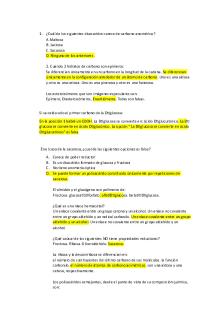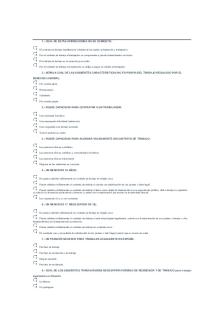Preguntas TEST - CG - Test PDF

| Title | Preguntas TEST - CG - Test |
|---|---|
| Course | Mecánica de Fluidos |
| Institution | Universitat Politècnica de Catalunya |
| Pages | 4 |
| File Size | 97.1 KB |
| File Type | |
| Total Downloads | 20 |
| Total Views | 149 |
Summary
CG - Test...
Description
In a Bode diagram, integrators and derivators cut the unit gain (0 dB) at frequency 0 rad/s You can use the double Bode diagram to study the stationary state response of a linear stable system to periodic inputs In a Bode diagram every real pole contributes decreasing gain 20 dB/dec from its natural frequency The root locus technique studies the stability, precision, speed and oscillations of a control system that adds to the plant, a proportional controller and a feedback You can obtain some information of the periodic response of unstable systems from their Bode diagrams but then you cannot read the complete stationary state response Only unstable systems can present oscillations It is always a good idea to have a feedback control system.
You cannot draw the Bode diagram of a systems with non-minimum phase poles because it is unstable In a Bode diagram every pair of complex zeros contributes increasing gain 40 dB/dec from its natural frequency
No se si estan be: We can only draw a root locus for stable plants. We must not represent Bode diagrams for a system with poles of positive real part If we have both GM (in dB) and PM positive the control system is stable for a unit proportional controller A system cannot have a negative sign A plant is any existing system that we want to control You can also read the stationary state value of the response to periodic inputs from the Bode diagrams of system with integrators or purely imaginary poles Every stable pole in a transfer function can compensate for an unstable one A feedback transfer function cannot have a negative sign If we have infinite GM and positive PM the control system is stable for any positive proportional controller If some of poles (roots of the denominator polynomial) of a continuous transfer function have positive real parts the system is absolutely unstable
A plant is any existing system that we want to control (creo) If we can design a stable system and we can make it useful then we can ask for efficiency If we increase the gain of the proportional controller (in the main branch) and we have infinite GM, the control system becomes more precise (creo) In a Bode diagram every pair of complex zeros contributes increasing gain 40 dB/dec from its natural frequency You can use the root locus technique both in open and closed loop Speed is more important than the absence of oscillations You can use the double Bode diagram to identify an unknown plant because of its logarithmic representations (summed contributions) If we have a negative sign anywhere except in the adder (comparison) but we can keep stability, we are going to need a second negative sign to compensate for it You use the root locus technique to draw the location of the closed loop poles Only stable systems can present oscillations
Test de classe You can use root locus in both open and closed loop. Root locus gives you information about the closed loop. Root locus gives you information about the open loop. You can use Bode diagram both in open and closed loop You can also observe the time step response by reading a Bode diagram The gain of all physical systems goes to zero as input frequency approaches infinite By adding an amplification factor you can have gain even for very high frequencies The natural frequency is where gain behavior (asymptotically) starts to change Gain behavior always changes from frequency zero Every real pole contributes increasing gain 20 dB/dec from its natural frequency Every real pole contributes decreasing gain 20 dB/dec from its natural frequency Every pair of complex zeros contribute increasing gain 40 dB/dec from its natural frequency Every pair of complex zeros contribute decreasing gain 40 dB/dec from its natural frequency
Integrators and derivators start to act from frequency zero Integrators and derivators start to act from frequency one Integrators and derivators would cut 0 dB at frequency zero Integrators and derivators would cut 0 dB at frequency one The maximum overshoot of a pair of complex poles happens a bit before its natural frequency The maximum overshoot of a pair of complex poles happens at its natural frequency You only go beyond the asymptotes for damping factor smaller than 1 You only go beyond the asymptotes for damping smaller than 0.5 If you cannot define both PM and GM you know nothing about closed loop stability If you cannot define both PM and GM they are infinite and you have closed loop stability You can observe PM both in Bode diagrams and root locus You can observe GM both in Bode diagrams and root locus
Lead (phase lead) compensators first add a zero and then a pole Lead (phase lead) compensators first add a pole and then a zero A PI controller is a particular case of a lead compensator A PI controller is a particular case of a lag compensator...
Similar Free PDFs

Preguntas TEST - CG - Test
- 4 Pages

Test preguntas - test
- 4 Pages

Preguntas TIPO TEST Resueltas
- 6 Pages

Preguntas TIPO TEST HS5
- 35 Pages

Preguntas tipo test
- 3 Pages

TIPO TEST, preguntas
- 10 Pages

Preguntas TEST HS4
- 26 Pages

preguntas tipo test
- 28 Pages

Test 200 preguntas
- 28 Pages

TEST Abril 2018, preguntas
- 3 Pages

Preguntas TEST Religión
- 9 Pages

Preguntas-test-inmunología
- 56 Pages

Preguntas tipo test
- 3 Pages

Tipo test 2021, preguntas
- 7 Pages
Popular Institutions
- Tinajero National High School - Annex
- Politeknik Caltex Riau
- Yokohama City University
- SGT University
- University of Al-Qadisiyah
- Divine Word College of Vigan
- Techniek College Rotterdam
- Universidade de Santiago
- Universiti Teknologi MARA Cawangan Johor Kampus Pasir Gudang
- Poltekkes Kemenkes Yogyakarta
- Baguio City National High School
- Colegio san marcos
- preparatoria uno
- Centro de Bachillerato Tecnológico Industrial y de Servicios No. 107
- Dalian Maritime University
- Quang Trung Secondary School
- Colegio Tecnológico en Informática
- Corporación Regional de Educación Superior
- Grupo CEDVA
- Dar Al Uloom University
- Centro de Estudios Preuniversitarios de la Universidad Nacional de Ingeniería
- 上智大学
- Aakash International School, Nuna Majara
- San Felipe Neri Catholic School
- Kang Chiao International School - New Taipei City
- Misamis Occidental National High School
- Institución Educativa Escuela Normal Juan Ladrilleros
- Kolehiyo ng Pantukan
- Batanes State College
- Instituto Continental
- Sekolah Menengah Kejuruan Kesehatan Kaltara (Tarakan)
- Colegio de La Inmaculada Concepcion - Cebu

